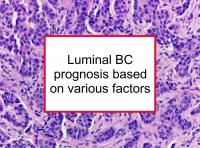A new study has reported that recurrence patterns of luminal breast cancer can differ based on histological characteristics of the tumors. Researchers are increasingly categorizing breast cancer according to whether it is luminal, basal or HER2-positive. These are molecular phenotypes, as determined by gene expression profiling.
Generally speaking, luminal breast cancer is either estrogen receptor positive/progesterone receptor positive (ER+/PR+), ER+/PR- or ER-/PR+, as well as being HER2 negative. The identification of special types of breast cancer might be helpful in assessing prognosis and forecasting response to treatment.
The study included 7,372 consecutive patients with invasive luminal breast cancer who underwent treatment at the European Institute of Oncology from 1997 to 2005. The women were followed for a median of 5.8 years. A total of 5,707 of the women had pure ductal breast cancer, 851 had lobular, 338 had mixed ductal and lobular, 250 had cribriform, 143 had mucinous and 83 had tubular carcinomas.
Ductal breast cancer develops in the milk ducts of the breasts, lobular breast cancer forms in the cells that line the milk-producing glands, cribriform breast cancer invades the connective tissues between the ducts and lobules with a Swiss cheese-like pattern, in mucinous breast cancer the tumor cells are poorly defined and produce mucus, and tubular tumor cells have a tubular structure when viewed under the microscope.
Women with cribriform or tubular tumors had approximately half the five-year risk of breast cancer recurrence as those with pure ductal breast cancer. Those with mucinous tumors had similar breast cancer-free survival as those with ductal breast cancer. On the other hand, women with lobular breast cancer were somewhat more likely to experience a recurrence than those with ductal breast cancer. The authors conclude that tubular, cribriform and lobular carcinomas have different prognostic implications.
Please see our articles on ductal breast cancer and lobular breast cancer prognosis for more information.
